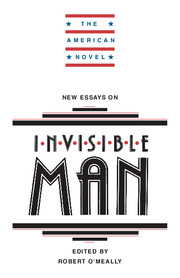Book contents
- Frontmatter
- Contents
- Series Editor's Preface
- 1 Introduction
- 2 The Meaning of Narration in Invisible Man
- 3 Frequencies of Eloquence: The Performance and Composition of Invisible Man
- 4 Ralph Waldo Ellison: Anthropology, Modernism, and Jazz
- 5 Ellison's Masks and the Novel of Reality
- 6 The Conscious Hero and the Rites of Man: Ellison's War
- Notes on Contributors
- Selected Bibliography
5 - Ellison's Masks and the Novel of Reality
Published online by Cambridge University Press: 05 June 2012
- Frontmatter
- Contents
- Series Editor's Preface
- 1 Introduction
- 2 The Meaning of Narration in Invisible Man
- 3 Frequencies of Eloquence: The Performance and Composition of Invisible Man
- 4 Ralph Waldo Ellison: Anthropology, Modernism, and Jazz
- 5 Ellison's Masks and the Novel of Reality
- 6 The Conscious Hero and the Rites of Man: Ellison's War
- Notes on Contributors
- Selected Bibliography
Summary
For the first time, the stage scenery of the senses collapsed; the human mind felt itself stripped naked, vibrating in a void of shapeless energies. … Society became fantastic, a vision of Pantomime with a mechanical motion.
–Henry Adams, The Education of Henry AdamsI began this search for the real in a book called Personae, casting off, as it were, complete masks of the self in each poem. I continued in a long series of translations, which were but more elaborate masks.
–Ezra Pound, Gaudier-BrzeskaWhat! The world a gradual improvisation?
–George Santayana, Winds of DoctrineAlthoughInvisible Man appeared in 1952, Ralph Ellison's literary career had begun in 1937, at Richard Wright's firm insistence, with a review of Waters Turpin's novel These Low Grounds for the Communist-funded magazine New Challenge. In the period between 1937 and 1952, Ellison published nine short stories and dozens of essays and reviews. Ellison's development during much of that time helps bring into full relief this transitional period in American fiction, for although his compass inscribed roughly the same are that others' had, from economic determinism and class consciousness to private psychological interpretations of experience, Ellison's Invisible Man retains a broad political focus on both race consciousness and national culture by redefining the terms of social reality.
- Type
- Chapter
- Information
- New Essays on Invisible Man , pp. 123 - 156Publisher: Cambridge University PressPrint publication year: 1988
- 3
- Cited by

